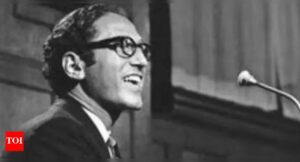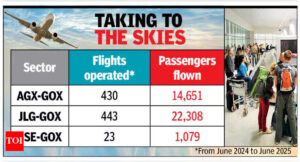Dubai brokers earn a stunning AED 3.23 billion in just six months, land department reveals | World News

A Record Year in the Making
Dubai’s real estate market is not just having a good year, it’s having its best one yet. In the first six months of the year, the market recorded its strongest mid-year performance to date. Total real estate transactions reached over AED 431 billion (approx. $117 billion) representing a 25 percent year-on-year increase. This growth was not only driven by property sales, but also by a wider set of real estate procedures that reflect a healthy and active market. Behind these numbers is a combination of policy changes, local and foreign investor confidence, and the steady expansion of supporting sectors such as real estate brokerage. Government strategies like the Dubai Economic Agenda D33 and the First Time Home Buyer Program have made it easier for residents and new investors to enter the market, while improved digital infrastructure and regulatory clarity have reduced friction in buying and selling property. This is not a short-term trend. The numbers show increasing participation from UAE residents, first-time buyers, and professionals working in real estate services, indicating that the market’s growth is built on a broad base.
The Engine of Growth: Brokers Take Center Stage
Real estate brokers have played a central role in Dubai’s property surge this year. In the first half of 2025, 42,181 transactions were completed through brokers. These deals generated more than AED 3.23 billion (approx. $880 million), in commissions, nearly double the AED 1.62 billion ($440 million) earned in the same period in 2024. This marks a 99 percent increase year-on-year. A significant reason for this spike is the sheer growth in the number of professionals entering the field. The Dubai Land Department (DLD) now lists 29,577 registered brokers, including 6,714 newcomers who joined in H1 2025 alone. This influx reflects growing trust in the sector, and in brokerage as a viable, high-value profession contributing meaningfully to the city’s real estate infrastructure. One standout development in the brokerage landscape is the rise of female participation. Today, 10,100 women are actively working as brokers, contributing to 13,424 transactions and generating nearly AED 1.43 billion (approx. $390 million) in commissions. Their growing presence highlights a shifting dynamic in deal-making, with women playing increasingly central roles in sales, negotiations, and client relationships.
Beyond Transactions: A Wider Ecosystem
The brokerage ecosystem now includes 1,223 registered brokerage offices and 78 property valuation offices employing 118 licensed valuers. In addition, 2,426 registered real estate services offices continued to play a pivotal role in the sector. During the first half of the year, Real Estate Registrations and Services Trustees Offices facilitated 114,848 transactions, serving 86,398 customers, marking a 15% increase in the number of customers compared to the same period last year. These offices handle key functions such as documentation, transaction processing, and regulatory compliance, forming a reliable bridge between buyers, sellers, and developers. This support network reinforces Dubai’s position as a transparent, well-regulated, and investor-friendly real estate market.
The Bigger Picture: Unprecedented Market Performance
Zooming out, the broader real estate landscape in Dubai is thriving at every level. H1 2025 marked the strongest mid-year performance on record, with 125,538 real estate transactions, This is a 26 percent increase compared to the 99,947 transactions during the same period last year.The total value of these transactions rose from AED 345 billion (approx. $94 billion) in H1 2024 to AED 431 billion (approx. $117 billion) in H1 2025, reflecting a 25 percent annual increase. Over 1.3 million procedures were logged, ranging from property sales to leasing and renewals, illustrating a deeply liquid and dynamic market. Importantly, this wasn’t just a frenzy of activity, it was strategic and sustained, supported by significant investor interest and long-term buying behavior.
First-Time and Local Investor
Investor participation has also increased. A total of 94,717 investors were active in the market in H1 2025, up 26 percent from the previous year. These investors carried out 118,132 investments with a combined value of AED 326 billion, equivalent to approximately 88.8 billion US dollars. This compares to AED 234 billion, or 63.8 billion US dollars, in H1 2024, reflecting a 39 percent increase in value.Within this group, 59,075 were first-time investors, marking a 22 percent rise from last year. These new participants contributed AED 157 billion, or 42.8 billion US dollars, to the market, which represents a 40 percent increase in investment value year-on-year. Notably, nearly 45 percent of these first-time investors were UAE residents, showing that government incentives and housing programs are succeeding in turning long-term residents into property owners. In the first half of 2025, Dubai attracted diverse capital inflows from key investor groups including:
- Foreign investors: AED 228.35 billion (approx. $62.2 billion)
- Arab (non-GCC) nationals: AED 28.4 billion (approx. $7.7 billion)
- GCC citizens: AED 22.56 billion (approx. $6.15 billion)
The market also saw strong participation from women investors. A total of 30,487 women executed 34,792 transactions, with a total value of AED 73.2 billion($19.9 billion). This reflects increasing involvement of women in wealth-building and property ownership, aligning with the broader trend of inclusive economic growth.
Where the Money Is Going: Top Investment Zones
Dubai’s property boom is geographically diverse. While traditional hotspots remain strong, newer zones are emerging with high transaction volumes and investment value: Top by Number of Deals:
- Al Barsha South Fourth: 10,469 transactions
- Al Yalayis 1: 7,595
- Wadi Al Safa 5: 7,178
- Business Bay: 6,601
- Dubai Marina: 6,428
- Airport City: 5,569
Top by Transaction Value:
- Dubai Marina: AED 25.1 billion ($6.83 billion)
- Business Bay: AED 22.5 billion ($6.12 billion)
- Burj Khalifa Area: AED 17.1 billion ($4.65 billion)
-
Palm Jumeirah : AED 16.96 billion ($4.61 billion) - Other Notables: Al Yalayis 1, Meaisem Second,
Mohammed Bin Rashid Gardens , each logging over AED 14 billion ($3.8 billion+)
This mix of waterfront developments, luxury zones, and emerging communities signals both a diversified portfolio of investor preferences and a robust supply pipeline.
What’s Fueling the Boom: Policy, Planning, and Trust
Dubai’s real estate success story in 2025 isn’t accidental. It’s the result of deliberate strategies, both legislative and visionary. Key drivers include:
- The D33 Economic Agenda: Aiming to position Dubai among the top three global cities economically.
- Dubai Real Estate Strategy 2033: Focused on long-term resilience, inclusion, and affordability.
- First Time Home Buyer Program: Offering preferential access, lower fees, and attractive mortgage terms for new buyers.
- Digital Reforms: Streamlined DLD services and transparent regulations.
- Stable Environment: In an increasingly volatile world, Dubai offers a mix of high returns, legal safety, and ease of doing business.
Together, these efforts have redefined Dubai from a transactional real estate market to a structured, investor-driven hub rooted in public-private partnership and long-term urban development.







